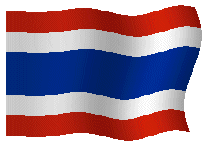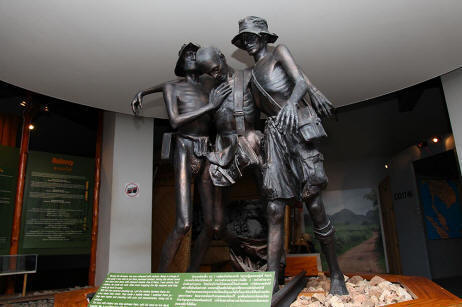

The Thailand - Burma Railway.
In June 1942, 61,000 allied troops and an estimated 200,000 labourers from India, China, Indonesia, Malaysia, Burma and Thailand were put to work by the Japanese Imperial Army to construct a railway line 415 km long to link Kanchanaburi to the Japanese base camp in Thanbyuzayat, thus ensuring a direct line from Singapore through Malaya and Thailand to link up with the railway network in Burma. Apart from supplying their bases in Burma, the Japanese also planned to use the railway to launch an attack on India.
Construction of the railway began on 16th September 1942. First estimates by Japanese engineers suggested that the line would take 5 years to build, but under tremendous pressure, the POWs completed the task in 16 months and the "Railway of Death" was finished on 25th December 1943.
The effects on the prisoners of war was devastating,
16,000 allies lost their lives together with 100,000 slave Asian labourers
during the construction. After the railway was finished, the remaining
prisoners were split into three groups. Those judged as being the
fittest, boarded slow Japanese merchant vessels for the treacherous sea
voyage to Japan, where they were to work in coal mines. Of the 10,000
men sent to Japan, as many as 3,000 are believed to have drowned at sea when
the ships in which they travelled were sunk by British and American
submarines. Those in the second group were considered fit enough to be
retained on the railway as maintenance crew. Up to 100 of these were
killed in allied bombing raids against the railway and the bridges across
the River Kwai. The third group of POWs were considered by the
Japanese to be too sick to be effective labourers and were sent back to
Changi Prison in Singapore.
Kanchanaburi War Cemetery.
Some 7,000 allied soldiers, sailors and airmen are buried in the cemetery.
The town museum has many artefacts from the railway construction, including actual parts of the original bridge on the River Kwai, railway tracks, personal items from both prisoners and Japanese and interactive displays of the entire railway route.

Two malarias and a cholera - the statue based on Ray Parkin's drawing which was adopted as the logo of Changi war museum in Singapore.
The Bridge on the River Kwai.
There were actually two bridges spanning the River Kwai in the Second World War. The original wooden bridge completed in February 1943 and the first train crossed the 11-span steel and concrete bridge, seen today, in June of the same year. This bridge was plundered by the Japanese from an oil field in Java and transported piece by piece to Kanchanaburi.
Allied bombing raids to destroy the two Kanchanaburi bridges began in late 1944 but it was not until February 1945 that both were temporarily knocked out.
The wooden bridge, repaired by allied prisoners, was again hit in April and the steel bridge in June. Destruction of the bridges was by then interrupting Japan's supply route to Burma and the service bridge was finally destroyed on the 2nd April 1945.
It was also in 1944 that the British began to take the offensive in Burma, where Thai troops were fighting alongside the Japanese.
Increasingly frequent allied bombing raids on the Thai home front did nothing to ease the population's concern about the course of the war and it was becoming apparent that Thailand's dictator Luang Philbunsongkhram (better known as Philbun) had led Thailand into the war on the wrong side. On the 24th July 1944, Philbun resigned. His successors, under the nominal leadership of Khuang Aphaiwong, but strongly influenced by the Free Thai movement of Pridi Phanomyong, made peace feelers toward the allies in the hope of avoiding accusations of Thai collaboration with Japan and a possible allied judgement of Thailand as an enemy nation.
We were fortunate while at the bridge, to see the Hong Kong Welsh Male Voice Choir singing.
A Japanese locomotive used on the railway.
Jeath War Museum.
Established in 1977. An open air museum, the main building is a realistic reconstruction of a prisoner of war hut. Built from bamboo, similar to those used as living quarters by POWs, it contains a large collection of photographs taken by Thai's and prisoners of war. There are also many paintings by prisoners as well as articles and letters written by former prisoners.
It was named the Jeath Museum because 'death' sounds too horrific. It is also an abbreviation of the names of the countries involved....Japan, England, America and Australia, Thailand and Holland.
And on a lighter note.............
Jordan and Leah get up close and personal with a couple of local Kanchanaburi 'moggies!'